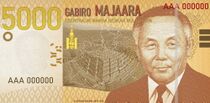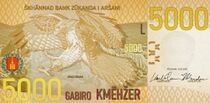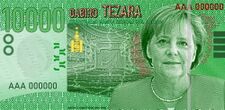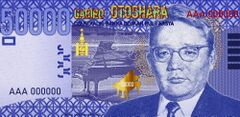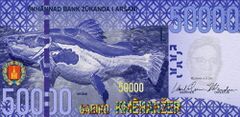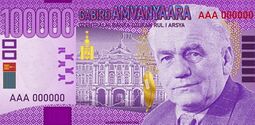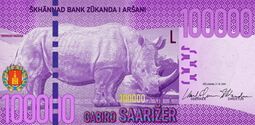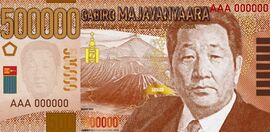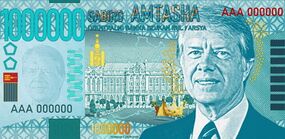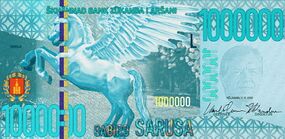Gabrielt Gabiro
| Gabiro (Gabrielt and Arsyan) | |
|---|---|
 10th Gabiro Series (2018-2012) | |
| Unit | |
| Symbol | ɢ |
| Denominations | |
| Subunit | |
| 1/100 | Zaka |
| Symbol | |
| Zaka | z |
| Banknotes | |
| Freq. used | ɢ.100, ɢ.200, ɢ. 500, ɢ.1000, ɢ.2000 |
| Rarely used | ɢ.5000 |
| Coins | |
| Freq. used | 5z, 10z, 25z, 50z, ɢ.1 |
| Rarely used | 1z, ɢ.2 |
| Demographics | |
| Date of introduction | 17 April 1926 1 January 2000 |
| User(s) | |
| Issuance | |
| Central bank | Central Bank of Gabrielland and Arsya |
| Valuation | |
| Inflation | 1% |
The Gabiro is the currency of Gabrielland issued by the Central Bank of Gabrielland and Arsya. It is one of the 4 currencies of the Dokodo Union, and Gabrielland is bound to adopt the Quasa once it fulfills the necessary requirements to join the Quasa Zone.
It was introduced in 1926 as the new currency of the recently formed union of Gabrielland and Arsya, replacing the Gabrielt Taga and the Arsyan Lirtta. The name Gabiro was agreed upon in the first parliamentary meeting of the union on the 19th of April 1926 as a combination of the Gabrielt word gaba meaning "money" and the Arsyan word kvirro, also meaning money. In 1976, the Dzakwanist government abolished money, and the Gabrio ceased to become legal tender in Dzakwanist Gabrielland. It was kept as the official currency of the newly-formed Arsyan Republic until the 1st of January 1977 until it was replaced by the Arsyan Lirtta, which would become the currency until 1985 when it was replaced with the Convertible Lirtta. The Gabiro was reintroduced on the 1st of January 2000, replacing the Convertible Lirtta at par. Due to high rates of inflation sustained during the civil war and the Arsyan Republic period, the Gabiro underwent redenomination in 2009, with 1 new Gabiro being equal to 1000 old Gabiros.
History
Predecessors
Both the Gabrielt and Arsyan confederations prior to 1926 have employed a currency union between member states tied to the value of silver. The Gabrielt Taga was used by almost all of the members in the Gabrielt confederation, with one notable exception being the State of Nevesia, while in the Arsyan confederation, it was universally accepted by all members, with subsets in the Grafenlandish Kingdom were allowed to retain their practice of minting and printing the Granfelnadish crown, though now with their value at par with the Lirtta, and its interchangeability with the Lirtta guaranteed. In essence, the Gabrielt Taga and the Arsyan Lirtta were interchangeable by their weight in silver or gold, and theoretically could be used in both confederations, though most merchants and traders were reluctant to do so in fears of low acceptability and the sudden debasement of the other currency.
The value of the Gabrielt Taga was fixed using the 5 Taga coin being equal to around 5.5g of fine silver, or the equivalent of 0.35g of fine gold. The Arsyan Lirtta was fixed using the 2½ Lirtta coin, known as the "Lirt" being equal to around 0.5g of fine gold, or the equivalent of 7.86g of fine silver. It could be inferred that 1 Taga was equal to 1.1g of fine silver, and 1 Lirtta being equal to around 3.15g of fine silver. It could be inferred that the conversion between the Gabrielt Taga and the Arsyan Lirtta was set at 1.1 : 3.15, or around 2.864 Tagas for each Lirtta, or around 0.349 Lirttas for each Taga. This figure would later be codified into the acts of friendship and unity of 1924, two years preceeding the unification of Gabrielland and the Arsyan Realms. The treaty also stipulated the acceptance of coins and banknote from both confederations in the other, thus creating a semi-monetary union between the two.
Negotiations would take place after in the months following the 1924 agreement. On the 21st of October 1924, prominent ministers and economists from both sides met in Vailhims to discuss a potential single currency and market for the two confederations, with the ultimate goal being unification of the two confederations. The high number of Gabrielt coins struck in silver in comparison to the high number of Arsyan coins struck in gold meant that there was an oversupply of silver in the Gabrielt confederation and an oversupply of gold in the Arsyan confederations. As a result, both the Taga and Lirtta deviated from its agreed value by as much as 15% depending on which commodity is sought after in the global stage. It was agreed that a single currency needed to be created and overseen by a single body to ensure that the government was able to maintain the set value agreed upon in the 1924 agreement.
The Gabrielt and Arsyan National Bank was created on the 12th of February 1925 in preparation for unification. The issuance and management of the Taga and the Lirtta was fully handed over to this bank in order to regain control over the fluctuating prices of both currencies. An equal number of coins were being struck in gold and silver, and a unified reserve means that banknotes being backed in either silver or gold could be printed accordingly. As the Taga and the Lirtta were under the helm of one unified bank, they both acted like a single currency, and therefore was the penultimate predecessor of the Gabiro. While the Taga and Lirtta were kept as separate currencies internationally, coins and banknotes bore both values in Taga and in Lirtta, simplifying economic transactions and cross-country trade. Fiscal policy was also united, thus bringing the end to Gabrielt and Arsyan monetary independence in favor of a unified monetary policy.
On the 19th of November 1925, a few months before independence, the Gabiro was proclaimed by the Gabrielt and Arsyan National Bank, overseen by the comittee for the unification of Gabrielland and the Arsyan Realms, as the new and sole currency of the new unified country. The Gabiro is a portmanteau of the Gabrielt word gaba meaning money, and kvirro, the Arsyan word for money and a currency that once was circulated in the Arsyan realms. The Gabiro became the currency of Gabrielland upon unification in April of 1926.
Transition to the Gabiro
Upon unification on the 17th of April 1926, the Gabiro was universally adopted as the sole currency of the new republic. It had been agreed upon that a bimetallic standard would be hard to implement and to maintain due to the fluctuation of both commodities that could not be pinned down into a single ratio. As such, silver was adopted as the new standard, with 1 Gabiro equal to 2.15g of silver, with 1 old Taga being equal to 0.511 Gabiros, and 1 old Lirtta being equal to 1.46 Gabiros. Old Gabiro and Lirtta coins and banknotes remained legal tender in Gabrielland, and was actually the only forms of the Gabiro used until the 1st of May 1926 as no banknotes specifically made for the Gabiro had been issued and printed. To ease conversion and the high amounts of money that circulated, fearing inflation woes and troubles, the official conversion at any bank or exchange center was set at 1 Taga = 0.5 Gabiros, and 1 Lirtta = 1.45 Gabiros, slightly less than their face value.
The first banknotes and coins to be issued for the Gabiro was done so on the 1st of May 1926, when the 50 Zaka and 1 Gabiro coins were first minted, and the 5 Gabiro banknote was released. During the first few years of unification, most prices were displayed both in the old denominations and in Gabiros, with the official conversion rate for Gabiros against silver being the standard. Due to the slight difference in conversion and in actual face value, larger banknotes of previous series were much less likely to be traded in with their Gabrielt equivalents after the first Gabiro denominations were issued, as the difference in value could sometimes be very noticeable. For eample, the 1000 Taga note had an almost 10 gabiro difference when converted into gabiros and when traded in at face value, which was the bi-weekly wage of an average laborer in Gabrielland at the time.
In 1927 and 1928, more banknotes and coin denominations were released, and by 1929, the all denominations of the first series had been released. The old Taga and Lirtta denominations started to disappear as businesses and other establishments were mandated to trade them in with Gabiros at representative offices of the central bank at each repsective location.
The first series of notes lacked security and protection, and were heavily counterfeited. It was approximated that 10% of all circulating banknotes were counterfeit in 1934. To combat this, the national bank issued another family of banknotes now known as the second series in 1939.
Republican era
In 1948, the Gabiro was made the sole official medium of exchange within the nation. Silver and gold coins were no longer worth their value in their metals but in their denomination, thus propmting a massive wave of melting old taga and lirtta coins which which still had some silver or gold content within them as opposed to the new coins minted for the Gabiro which was minted using more representative materials such as alumunium or nickel. As the precious metal content within the coins exceeded their face value, a short inflatory period known as the "gold hike" occured in 1949, when massive amounts of old coins containing either of the precious metals were melted and converted into the Gabiro.
The Gabiro enjoyed modest growth after its cementing as the national currency of Gabrielland. After a series of devaluations against silver in 1945, 1951, and 1954 to accomodate the spike in monetary demand, the gabiro was taken off the silver standard in 1956 according to Law No. 12 of 1956 regarding the Gabrielt gabiro. The gabiro became a free-floating currency afterwards. The gabiro traded at 9.48 gabiros per ACU in 1960.
Prelude to the civil war
Rising tensions and inequality between different parts of Gabrielland caused the gabiro to depreciate against the ACU as demand for the gabiro weakened in the early 1970s. As the gabiro weakened, inflation hit the double digits for the first time since 1948 in 1972. To combat this, the national bank printed banknotes of larger and larger denominations, beginning with the 1000 gabiro note in 1971, the 2500 gabiro note in 1973, and finally the 5000 gabiro note in 1975. With inflation soaring, the national bank reversed course and limited the amount of money circulating while exhausting foreign reserves to buy the Gabiro in order to prop up its value. In late 1975, all gabiro banknotes which had a value greater than 500 gabiros were to be "cut" in half with the left side of the banknote being legal tender, and the right side of the banknote being a government bond with a 5% interest to be paid in 10 years time. The national bank intends to use the bonds to prop the Gabiro's value.
The strategy backfired when massive riots engulfed most of Gabrielland, especially in central Gabrielland. A group named the People's Dzakwanist Party capitalized on the ensuing chaos and proclaimed that money was the root of all calamities and disasters, and should be abolished in favor of a more communal lifestyle similar to that mentioned in Dzakwanist literature.
Civil war and abandonment
By 1976, the People's Dzakwanist Party managed to occupy most of central and western Gabrielland as well as half of Vailhims. The capital was moved from Vailhims to Sangur which was 600 km from Vailhims in order to secure government information and details. This period was known as the Arsyan Republic period both officially and historically to differentiate itself from the old Gabrielt republic which had become splintered in two in civil war. The Gabiro went into a freefall after its use was banned by the PDP in all PDP dominated areas. In areas not under the control of the PDP, the gabiro had already lost its credibility and value, and citizens opted to use either foreign currency or commodity-backed notes issued by individual banks.
In late 1976, the Arsyan Central Bank was established on top of the ruins of the National Bank of Gabrielland and Arsya. The bank quickly transferred all the silver and gold in the old bank's coffers to the new location in Sangur, and proclaimed a new currency named the lirtta, a name previously used by the Arsyan confederation. The lirtta was not tied to the old gabiro in any way, nor was it tied to the silver and gold reserves of the Arsyan Central Bank. The Arsyan Central Bank initially set the value of one lirtta to be equal to one ACU, and let the currency depreciate as much as it needed to to reach an equilibrium point.
In 1980, Dzakwanist Gabrielland reunited with the Arsyan Republic after forces resigned. The lirtta remained the official currency while public sentiment increased, slowing the depreciation of the currency. A five-year rebuilding plan was enacted, which stipulated that the lirtta remain the official currency of the Arsyan Republic until the completion of the five-year plan. In 1985, the lirtta was renamed to the convertible lirtta to emphasize that the lirtta was able to be traded into any currency or commodity just like any other commodity. The convertible lirtta equaled 1,000 lirttas during conversion.
Reintroduction
In 2000, Gabrielland was reorganized into a confederation with the gabiro once more as the currency. This gabiro had no connection or continuity with the previous gabiro once circulated in Gabrielland. The value of the new gabiro was equal to that of the convertible lirtta. In 2000, the gabiro traded at around 1389 gabiros per ACU. The first set of banknotes for the gabiro wasn't released until early 2001. Until then, overstamped denominations done by the newly-formed Central Bank of Gabrielland and Arsya of the old convertible lirtta banknotes served as legal tender.
In 2009, the gabiro was redenominated at a ratio of 1:1000 due to inflation sustained under the previous 30 years. Banknotes and coins reflected the change by appending the adjective bavi "new" after the denominations of the gabiro.
Banknotes
The Gabrielt Gabiro has seen several banknote series being released into general circulation. A total of 9 separate banknote families have been released between 1926 and 2018, with the latest series being released in 2018. A 10th series is scheduled to be released in 2024. Below is a list of banknote families released by the Central Bank of Gabrielland and Arsya and their withdrawal date.
| Series | First Release | Withdrawal |
|---|---|---|
| 1 | 1 May 1926 | 1 January 1949 |
| 2 | 8 August - 17 September 1939 | 1 January 1964 |
| 3 | 11 May - 24 October 1954 | 1 January 1971 |
| 4 | 8 March 1961 | 1 January 1966 |
| 5 | 19 February 1965 | 1 January 1977 |
| 6 | 3 June 1973 | 1 January 1977 |
| 7 | 11 January 2001 | 1 January 2019 |
| 8 | 17 April 2009 | 1 January 2029 |
| 9 | 17 April 2017 | 1 January 2029 |
| 10 | 15 March 2024 | - |
7th series (2001)
The 7th series of the Gabiro was the fist series released by the Central Bank of Gabrielland and Arsya after its formation as the central bank of Gabrielland and Arsya. The series features national heroes from both Gabrielland and Arsya, as well as depicting national animals on the reverse side of the banknotes. This series did not have denominations that began with the numerla 2. The obverse side is written in standard Gabrielt, while the reverse side is in standard Arsyan. Due to its high value, the ɢ.500,000 and ɢ.1,000,000 banknotes were very rarely seen in circulation. In mid-2002, the ɢ.500,000 and ɢ.1,000,000 banknotes were worth 346.02 ACU and 692.04 ACU respectively, while the minimum wage in Vailhims was around ɢ.350,000 at the same time.
The banknotes remained legal tender until approximately 10 years after the release of the next series. The 7th series ceased to be legal tender in Gabrielland on the 1st of January 2019. Prior to that, banknotes were still accepted at all businesses and institutions with their value taken using the new redenominated value. No overstamp issues were released for the purposes of redenmoniation.
Below are the statistics for the 7th series on the date of the introduction of the 8th series. The serials XAA-XZZ were reserved for replacement notes. The second letter of the replacement notes series indicated which denomination it replaces. For example, a replacement note for the ɢ.10,000 denomination would have a serial of XNA 000001 — XQZ 999999.
| Denomination | Serial | Number in circulation | Value in Gabiro | Value in ACU | Percent of bills | Percent of value |
|---|---|---|---|---|---|---|
| ɢ.500 | AAA000001 — DZZ999999 |
946,965,711 | ɢ. 473,482,855,500 | 340,880,386 ACU | 13.446% | 0.307% |
| ɢ.1000 | EAA000001 — HZZ999999 |
1,581,756,773 | ɢ.1,581,756,773,000 | 1,138,773,775 ACU | 22.46% | 1.025% |
| ɢ.5000 | IAA000001 — MZZ999999 |
1,739,001,824 | ɢ.8,695,009,120,000 | 6,259,905,774 ACU | 24.692% | 5.632% |
| ɢ.10,000 | NAA000001 — QZZ999999 |
1,460,070,967 | ɢ.14,600,709,670,000 | 10,511,670,029 ACU | 20.732% | 9.457% |
| ɢ.50,000 | RAA000001 — UZZ999999 |
861,084,648 | ɢ.43,054,232,400,000 | 30,996,567,603 ACU | 12.227% | 27.888% |
| ɢ.100,000 | VAA000001 — WZZ999999 |
379,191,804 | ɢ.37,919,180,400,000 | 27,299,625,918 ACU | 5.384% | 24.562% |
| ɢ.500,000 | YAA000001 — YZZ999999 |
53,021,229 | ɢ.26,510,614,500,000 | 19,086,115,551 ACU | 0.753% | 17.172% |
| ɢ.1,000,000 | ZAA000001 — ZZZ999999 |
21,549,088 | ɢ.21,549,088,000,000 | 15,514,102,232 ACU | 0.306% | 13.958% |
| Total | AAA000000 — ZZZ999999 |
7,042,642,044 | ɢ.154,384,073,718,500 | 111,147,641,266 ACU | 100% | 100% |
8th series (2009)
The 8th series of the Gabiro was the first banknote family to be issued after redenomination. Due to redenomination, the adjective "new" was appended to the name and symbol of the currency, being the ɢʙ. or Gabiro Bavi "new Gabiro", without changing the official name and ISO code of the Gabiro. The number of denominations was slimmed down from 8 to 6, omitting ɢʙ.0.5, ɢʙ.1, ɢʙ.500, and ɢʙ.1000 (formerly ɢ.500, ɢ.1000, ɢ.500,000, and ɢ.1,000,000) while including new denominations of ɢʙ.20 and ɢʙ.200 (formerly ɢ.20,000 and ɢ.200,000). The ɢʙ.500, and ɢʙ.10,00 were deemed very easy targets for money laundering and counterfeit, and thus were omitted. They previously also had very low circulation numbers, and were rarely seen by the general public.
The banknotes feature prominent Gabrielt and Arsyan poets, playrights, and other artists, celebrating their works and contribution towards the richness of Gabrielt culture and society on the obverse and selected Gabrielt landscapes and locations on the reverse. The banknotes have a more modern and updated look when compared to the 7th series.
| Banknotes of the 8th series (2009) | |||||||||||||||||||||||||||||||||||||||||||||||||
|---|---|---|---|---|---|---|---|---|---|---|---|---|---|---|---|---|---|---|---|---|---|---|---|---|---|---|---|---|---|---|---|---|---|---|---|---|---|---|---|---|---|---|---|---|---|---|---|---|---|
| Image | Dimensions | Denomination | Main color | Description | Date of | ||||||||||||||||||||||||||||||||||||||||||||
| Obverse | Reverse | Obverse | Reverse | Watermark | First issued | Withdrawal | |||||||||||||||||||||||||||||||||||||||||||
| ɢʙ.5 | |||||||||||||||||||||||||||||||||||||||||||||||||
| ɢʙ.10 | |||||||||||||||||||||||||||||||||||||||||||||||||
| ɢʙ.20 | |||||||||||||||||||||||||||||||||||||||||||||||||
| ɢʙ.50 | |||||||||||||||||||||||||||||||||||||||||||||||||
| ɢʙ.100 | |||||||||||||||||||||||||||||||||||||||||||||||||
| ɢʙ.200 | |||||||||||||||||||||||||||||||||||||||||||||||||
9th series (2017)
| Banknotes of the 9th series (2017) | |||||||||||||||||||||||||||||||||||||||||||||||||
|---|---|---|---|---|---|---|---|---|---|---|---|---|---|---|---|---|---|---|---|---|---|---|---|---|---|---|---|---|---|---|---|---|---|---|---|---|---|---|---|---|---|---|---|---|---|---|---|---|---|
| Image | Dimensions | Denomination | Main color | Description | Date of | ||||||||||||||||||||||||||||||||||||||||||||
| Obverse | Reverse | Obverse | Reverse | Watermark | First issued | Withdrawal | |||||||||||||||||||||||||||||||||||||||||||
| ɢ.5 | |||||||||||||||||||||||||||||||||||||||||||||||||
| ɢ.10 | |||||||||||||||||||||||||||||||||||||||||||||||||
| ɢ.20 | |||||||||||||||||||||||||||||||||||||||||||||||||
| ɢ.50 | |||||||||||||||||||||||||||||||||||||||||||||||||
| ɢ.100 | |||||||||||||||||||||||||||||||||||||||||||||||||
| ɢ.200 | |||||||||||||||||||||||||||||||||||||||||||||||||
The 9th series of the Gabiro, more colloquiall known as the "Sontuvian" series after Finance Minister Gahttari Sontuvia, was first commissioned by the Central Bank of Gabrielland and Arsya around October of 2012, with a press report dated 15 October 2012 detailing the central bank's plan to further increase the safety and security of the Gabiro, as well as to keep the fresh look of the Gabiro. The term Gabiro Bavi was dropped from all official documentation and reverted back to the original symbol and name. Although released in 2017, notes still bear "2013" when the official bills were signed into law.
The series maintains the denominations found in previous bill, and carries the imprint "2013-2017".
10th series (2024)
On the 15th of June 2022, Central Bank Governor Kavan Samundiwan announced that a new family of banknotes is being prepared for release in mid-2024. Denominations are unlikely to change.




